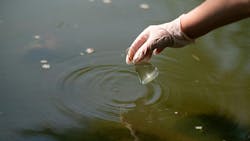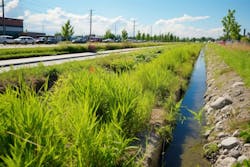Water monitoring frameworks: Back to basics for meaningful results
When it comes to watershed health, it is crucial to understand the movement, distribution and quality of water as it moves through a system. With stormwater runoff being a known source of pollutants within a watershed, monitoring the impacts of stormwater systems on natural receiving water bodies is the main objective for numerous water monitoring programs. For many of these programs, assessing the performance and effectiveness of stormwater infrastructure is a key piece in characterizing the health of watersheds.
Understanding the health of a watercourse and its surrounding watershed may seem straightforward: simply collect a water sample and send it off to a laboratory for analysis. When the results come in, review and report the results and come to a conclusion. End of story. Or is it? There is a lot more that goes into water quality monitoring than just the physical collection of a sample.
Beyond the numbers
Analytical results are more than just numbers. Simply reporting parameters and associated values is meaningless unless assumptions and pertinent supporting information are provided. When reviewing a results summary table or laboratory report, it can help to evaluate the numbers with a critical eye. And this is when the questions start to formulate. What was the purpose of the monitoring? Is there a figure showing exactly where the sample was collected? What features are upstream or downstream of the sample location? What was the rationale for the parameters selected? Are the detection limits applicable? Was it raining at the time of sampling? All these questions and more can all be answered if a comprehensive monitoring plan and reporting framework have been developed.
On the surface, a single water sample is a snapshot in time. If the purpose of monitoring is to understand conditions at a certain point in time, then this type of discrete sampling method may be sufficient. But if you want to understand the overall health of a watercourse and the surrounding watershed over time, there is more to consider than water quality sampling alone.
Setting monitoring objectives
Typically, the reason anyone starts a monitoring program is to answer a question or understand what is occurring within a system. Monitoring objectives can range from requirements to meet agency mandates to proactive information gathering to further understand baseline or current conditions. The goals and objectives of a program dictate what, where, when, why and how certain parameters are monitored.
An initial framework helps to outline the overall approach and establishes the key pieces that make up a monitoring plan. The plan will dictate the type of monitoring to be completed, whether it is a physical inspection of a specific stormwater feature or system, or water quality monitoring for a specific parameter from a chemical perspective. As the analysis of results will vary depending on the objectives, setting clear goals well before program initiation is critical to ensure meaningful information is being collected.
When it comes to monitoring stormwater infrastructure, there are typically two categories: water quality and water quantity. Water quality monitoring of stormwater systems focuses on determining the performance of stormwater designs to evaluate their functionality or how effective they are with pollutant removal. Water quantity focuses on measuring physical parameters, such as water depth, velocity, and flow, to characterize how water is conveyed through the system.
The main purpose of stormwater infrastructure inspections or condition assessments are to evaluate the functionality of a feature based on its physical condition at a particular time, whether that is post-construction or after years of operation. It allows one to identify deficiencies in performance and then provide recommendations to address any issues through specific operation or maintenance needs. An example of this would be an inspection of a stormwater management pond or detention basin, which could include an inspection for blockages or the integrity of inlets and outlets, as well as visual observations of the water within the basin for things such as excess vegetation growth, presence of algae, or areas of sediment deposition or erosion.
When it comes to performance monitoring for water quality, this involves the evaluation of stormwater runoff or receiving water bodies with respect to pollutant concentration, which can then inform a feature’s effectiveness at removing the pollutants it was designed to manage. This type of monitoring is typically performed by collecting in-field water quality measurements, such as temperature or pH, and/or water samples that are then sent off to a lab for chemical analysis for parameters such as total suspended solids, oil and grease, or metals.
Building your framework
Whether the objective is to monitor water quality or water quantity, one first needs to establish a monitoring framework. Even the most straightforward monitoring programs benefit from a well-thought-out and comprehensive monitoring framework. A good place to start is to identify the type of water system to be monitored: an engineered water system or a natural water system.
In the context of stormwater monitoring, engineered water systems include traditional grey infrastructure (e.g. flood control channels, dams, spillways, detention basins and culverts), but they also include green infrastructure (e.g. constructed wetlands, bioretention areas or rain gardens, and infiltration-based systems). Monitoring these systems can help identify stormwater-related issues that may occur, such as erosion, sedimentation, and infrastructure failures. Natural water systems would be the receiving water system (e.g. streams, rivers, lakes, natural wetlands) and can include either fresh or saltwater systems.
Both types of systems are typically monitored for planning purposes, such as when you collect field data to develop a rating curve that relates water level to flow, or to validate a model that was designed using theoretical engineering methods. You can also monitor these systems for design verification purposes or permit conformance purposes to meet regulatory requirements.
Indicators beyond water quality
Beyond water quality, other watershed health indicators can include water quantity, streambank stability, and ecological indicators such as benthic invertebrates, fish communities, and even vegetation health, all of which can provide further context and a more holistic understanding of the health of a watercourse or watershed. It is also important to understand how these attributes interact and affect others. For example, water quality does not directly alter hydrology; however, hydrology can increase or decrease the movement of pollutants. Another example: consider how water quality affects biological conditions, as it directly affects aquatic communities such as benthic invertebrates and fish.
Numerous guidance documents already exist for the development of monitoring programs and are great resources, as many are tailored to a specific region or climate. As a starting point, a typical monitoring framework would include the following steps which could then be expanded out in more detail to develop a comprehensive monitoring plan:
- Define monitoring objectives;
- Review existing information and dates;
- Define the study area and monitoring boundaries;
- Define the monitoring locations and parameters;
- Determine methodologies and techniques for monitoring, data collection and analysis;
- Identify reporting requirements; and
- Refine the monitoring plan as needed throughout program execution.
From there, monitoring plan details should include a recommended parameter list and associated detection limits, sample locations, sample collection methods, health and safety considerations, sample frequencies, data processing procedures, quality control/quality assurance, and parameter triggers. Meteorological parameters, such as precipitation in the form of rain and snow, evaporation and air temperature, should also be included.
Considerations for data management and storage are also important, especially when multiple stakeholders are collecting data. Having a comprehensive plan allows for consistent data collection and analysis methods, which can be used by anyone who monitors within a watershed or system. Tools such as a consolidated virtual open data set allow everyone to access data and information and can allow transparency to the public if needed. These datasets can then be relied on to assess specific parameter trends and shifts from baseline conditions, allowing for the early detection of issues, whether they are stormwater infrastructure-related or evidence of changing conditions somewhere else in the watershed.
Whether the monitoring objective is specific to stormwater infrastructure or specific to holistic watershed health, time spent establishing a comprehensive monitoring framework is time well spent to ensure the efficacy of the development and execution of a focused and meaningful monitoring program.
About the Author
Sarah Andrew
Associate and Senior Water Resources Engineer at GHD
Sarah Andrew is an Associate and Senior Water Resources Engineer for the Ontario Integrated Water Management team at GHD. She specializes in surface water quality and quantity monitoring, as well as grey and green infrastructure design and performance monitoring. Andrew can be reached at [email protected].




